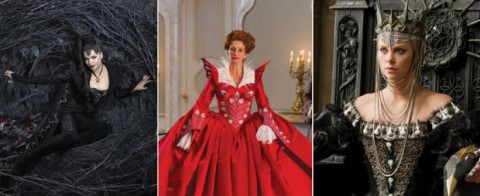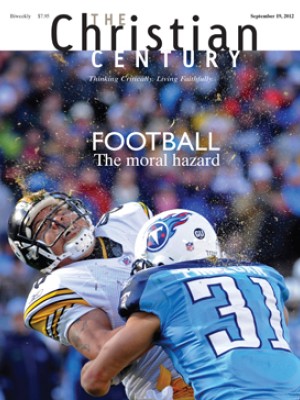Once Upon a Time; Mirror, Mirror and Snow White and the Huntsman

I’ve long imagined that the gender theorists at Walt Disney Productions are a bit embarrassed by the 1937 movie Snow White and the Seven Dwarfs, with its saccharine high-voiced heroine who longs for her prince to come. After all, recent Disney princesses make some feminist overtures. In Beauty and the Beast, the heroine Belle is a bookworm with no time for fluttering lashes; in The Little Mermaid, Ariel refuses the restraints of her sea king father; and in The Princess and the Frog, Tiana is a working woman, running her own restaurant with royal title in hand. Femininity as scripted by Disney represents no feminist victory, but it’s at least more complicated than it was decades ago. The princess tale of today can’t be told without some interaction with feminist critique.
Three current tales of Snow White all nod at feminist critique by putting weapons into Snow White’s hands. Nevertheless, the old paradigms for female power and beauty are left intact. The “fairest of them all” is none other than we’d expect her to be: she is very young, very rich and very, very white.
Read our latest issue or browse back issues.
Once Upon a Time, which begins its second season this month on ABC, features Snow White (Ginnifer Goodwin) and Prince Charming, who have been banished by the evil queen (played by Lana Parrilla) to small town USA. The show moves between the past, the land of magic, and the present, where Snow White and company have forgotten who they are. Snow White is a schoolteacher, and the prince has been in a coma. Their daughter, now seemingly the same age as Snow White, generally upstages them both. The queen’s hatred for Snow White is rooted in an old grudge. When Snow White was a child, she was tricked by the evil queen’s mother into disclosing the young queen’s love for a stable boy. The evil mother, clinging to her plan to wed her daughter to the king, kills the stable boy, and the queen then directs her vengeance at Snow White.
Mirror, Mirror, one of two summer Snow White films now available on DVD, is the least earnest of the three offerings. It’s a lush and farcical tale for tweens, which includes a disturbing moment in which the prince spanks Snow with a sword. Snow White (Lily Collins) flees from her evil stepmother (Julia Roberts) to get battle training and costume advice from a group of dwarves turned thieves. The queen has squandered her kingdom’s fortune on lavish parties; the prince offers an opportunity for her to marry for money. The queen’s plot against Snow White is meant to eliminate a rival for the prince’s fortune.
Snow White and the Huntsman, starring Charlize Theron as the magnificently wicked Queen Ravenna, is a dark fairy tale aimed at adults. The queen cannibalizes the beauty of the young in order to maintain her own beauty. Snow White (Kristen Stewart) flees just before the queen would have taken her heart. Snow spends a night in a community where the women scar their faces and those of their daughters to keep the queen from stealing their youth and beauty. The film offers a pair of rivals for Snow White’s affections—the huntsman and a childhood friend. Dressed in full armor, Snow White rides into battle with them both.
In all three stories, the evil queens play the most interesting parts. Parilla’s queen gets to abuse her power in both the real world and in fairyland. Roberts does a delightful bit of parody on beauty regimens involving lips plumped by bee stings, a bird poop facial and worms nibbling away at dead skin. Theron plays a more complicated character whose painful past is alluded to when she kills the king, saying, “Men use women, they ruin us, and when they are finished with us, they throw us to their dogs like scraps.” All three queens destroy their kings—by snake, spell or dagger—and all three queens—older, powerful women—want to destroy the innocent Snow White. None of the stories has room for the queen’s redemption, and none makes her more than a foolish woman past her prime who is usurping the rightful place of youth and beauty. Feminine beauty and power are achingly fragile and always problematic.
If we hope to imagine a different femininity, we will need much more than a soft, market-driven feminism and more than a princess who takes her turn in combat but does not ask about the nature of the good, beautiful and true. If we are to act faithfully and hopefully in a world that still believes that beauty goes with money and whiteness and still holds old women in contempt, we will need a theological notion of beauty and a christological understanding of power.
Where Snow’s beauty is white, the beauty of God’s kingdom is of every tribe and tongue and nation. Where the queen’s old age dooms her, Christians have a wisdom tradition in which “the glory of youths is their strength, but the beauty of the aged is their gray hair” (Prov. 20:29). Beauty is not a fleeting good, something we should claw after by the world’s rules. It is a good gift from God, who makes us beautiful in the sanctifying power of the Holy Spirit.
Female power is not more problematic than male power, as is suggested by these tales of a threatening queen who must be destroyed. Nor should it simply take the form of male power. It too is a good gift of a good God, who created male and female in the royal divine image and who gives us, male and female, proper royal dominion, a dominion exercised most clearly—and often surprisingly—in conformity to one who “has brought down the powerful from their thrones, and lifted up the lowly” (Luke 1:52).




